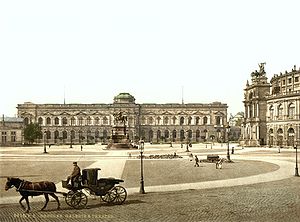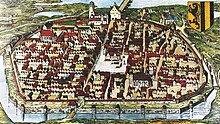The Dresden Zwinger was built at the turn of the 18th century by the Saxon Elector, Augustus the Strong to host aristocratic parties and balls. In 1710, the baroque prince had several hundred Italian orange trees planted at the Zwinger's orangery. Today, the Zwinger is home to several museums.
建成後[編輯]
茨溫格宮在1719年選帝侯腓特烈·奧古斯特與哈布斯堡皇帝的公主瑪利亞·約瑟法舉行婚禮之際正式揭幕,當時,建築的外殼已經豎立,加上臨時展館,構成這一活動突出的背景。內部直到1728年才完成,行使美術館和圖書館的功能。
1733年奧古斯特去世,因為其他地方需要資金,建造工程停止。宮殿區朝向森佩爾歌劇院廣場和河流。後來規劃改變,規模縮小,在1847年至1855年該地區由於興建美術館(現在被歌劇院與茨溫格宮分開)而被關閉;建築師是歌劇院的設計者戈特弗里德·森佩爾。
摧毀與重建[編輯]
茨溫格宮在1945年2月13-15日地毯式的德勒斯登大轟炸中基本被摧毀,在此之前,收藏的藝術品已經被撤退。戰後,德勒斯登市民舉行公民投票,決定重建茨溫格宮,以重建該市的榮耀,而不是將廢墟夷為平地,改建德意志民主共和國當時盛行的社會主義現實主義建築。
博物館[編輯]
儘管有些小,茨溫格宮的早期繪畫大師美術館(Gemäldegalerie Alte Meister)仍是德勒斯登豐富的文化遺產吸引力的主角。現在它收藏美術和科學珍寶的藏品。這裡收藏有彼得·保羅·魯本斯、加納萊托、拉斐爾等早期繪畫大師的繪畫。Rüstkammer 德勒斯登軍械庫對武器和盔甲有不錯的收藏,大多是16和17世紀的。這裡還收藏邁森瓷器、鐘錶和科學儀表。該建築還保存著 Mathematisch-Physikalischer 沙龍。
| Zwinger Dresden | |
|---|---|
 | |
| General information | |
| Architectural style | Neo-renaissance, Baroque |
| Location | Dresden, Germany |
| Construction started | 1710 |
| Completed | 1728 |
| Owner | Free State of Saxony |
| Design and construction | |
| Architect | Matthäus Daniel Pöppelmann |
| Other designers | Balthasar Permoser |
The Zwinger (German: Dresdner Zwinger, IPA: [ˈdʁeːzdnɐ ˈt͡svɪŋɐ]) is a palace in the German city of Dresden, built in Baroque style and designed by court architect Matthäus Daniel Pöppelmann. It served as the orangery, exhibition gallery and festival arena of the Dresden Court.
The location was formerly part of the Dresden fortress of which the outer wall is conserved. The name derives from the German word Zwinger (an enclosed killing ground in front of a castle or city gate); it was for the cannons that were placed between the outer wall and the major wall. The Zwinger was not enclosed until the Neoclassical building by Gottfried Semper called the Semper Gallery was built on its northern side.
Today, the Zwinger is a museum complex that contains the Gemäldegalerie Alte Meister (Old Masters Picture Gallery), the Dresden Porcelain Collection (Dresdener Porzellansammlung) and the Mathematisch-Physikalischer Salon (Royal Cabinet of Mathematical and Physical Instruments).
Contents
Current inner city location[edit]
The Zwinger covers an area on the northwestern edge of the Innere Altstadt ("inner old town") that is part of the historic heart of Dresden. It is located in the immediate vicinity of other famous sights, including Dresden Castle and the Semperoper. The Zwinger is bounded by Sophienstraße in the southeast, Postplatz in the south, Ostra-Allee in the southwest, the Am Zwingerteich road in the northwest and Theatre Square (Theaterplatz) in the east. Nearby buildings include the Dresden State Theatre to the southwest, the Haus am Zwinger to the south, the Taschenbergpalais hotel to the southeast, the west wing of the palace with its Green Vault to the east, the Altstädtische Hauptwache to the northeast, the Semper Opera to the north and the former royal stables to the northwest. Within view lie the Catholic Court Church and the Italian Village in Theatre Square, the Wilsdruffer Kubus on Postplatz and the Duchess Garden with the remnants of the former orangery building in the west. The terraced banks of the Elbe river are located 200 metres northeast of the Zwinger.
History[edit]
Origin of the name[edit]
The name Zwinger goes back to the common medieval German term for that part of a fortification between the outer and inner defensive walls, or "outer ward". Archaeological evidence indicates that the construction of the first city wall took place in the last quarter of the 12th century. A documentary entry as civitas in 1216 points to the existence of an enclosed Dresden Fortification at that time. In 1427, during the Hussite Wars, work began on strengthening the city's defences and they were enhanced by a second – outer – wall. These improvements began near the Wildruffer Tor gate. Step by step the old moat had to be filled in and moved. The area between the two walls was generally referred to as the Zwinger and, in the vicinity of the castle, was utilised by the royal court at Dresden for garden purposes. The location of the so-called Zwingergarten from that period is only imprecisely known to be between the fortifications on the western side of the city.[1][2] Its extent varied in places as a result of subsequent improvements to the fortifications and is depicted differently on the various maps.
This royal Zwingergarten, a garden used to supply the court, still fulfilled one of its functions, as indicated by the name, as a narrow defensive area between the outer and inner defensive walls. This was no longer the case when work on the present-day Zwinger palace began in the early 18th century, nevertheless the name was transferred to the new building. Admittedly the southwestern parts of the building of the baroque Dresden Zwinger including the Kronentor gate stand on parts of the outer curtain wall that are still visible today; but there is no longer any trace of the inner wall.[3]
Early development of the city in the area of the Zwinger[edit]
Until well into the 16th century, the area of the present-day Zwinger complex was still outside the city fortifications. Close by ran an old stretch of the Weißeritz river that no longer exists, which emptied into the Elbe by the Old Castle. In 1569, major work began on redevelopment and new buildings by the fortifications west of the castle based on plans by master builder, Rochus Quirin, Count of Lynar, who came from Florence. The embankments needed in the area of the river confluence proved to be a major challenge. In spring 1570 the Weißeritz caused severe flood damage at an embankment, which hampered the building project for a short time. Then, in 1572, the rebuilding work by the fortifications came to a temporary halt.[4]
Early history[edit]
Augustus the Strong, King of Poland and Elector of Saxony, returned from a grand tour through France and Italy in 1687–89, just at the moment that Louis XIV moved his court to Versailles. On his return to Dresden, having arranged his election as King of Poland (1697), he wanted something similarly spectacular for himself. The fortifications were no longer needed and provided readily available space for his plans. The original plans, as developed by his court architect Matthäus Daniel Pöppelmann before 1711, covered the space of the present complex of palace and garden, and also included as gardens the space down to the Elbe river, upon which the Semperoper and its square were built in the nineteenth century.
The Zwinger was designed by Pöppelmann and constructed in stages from 1710 to 1728. Sculpture was provided by Balthasar Permoser. The Zwinger was formally inaugurated in 1719, on the occasion of the electoral prince Frederick August’s marriage to the daughter of the Habsburg emperor, the Archduchess Maria Josepha. At the time, the outer shells of the buildings had already been erected and, with their pavilions and arcaded galleries, formed a striking backdrop to the event. It was not until the completion of their interiors in 1728, however, that they could serve their intended functions as exhibition galleries and library halls.
The death of Augustus in 1733 put a halt to the construction because the funds were needed elsewhere. The palace area was left open towards the Semperoper square (Theatre Square) and the river. Later the plans were changed to a smaller scale, and in 1847–1855 the area was closed by the construction of the gallery wing now separating the Zwinger from the Theatre Square. The architect of this building, later named Semper Gallery, was Gottfried Semper, who also designed the opera house.








沒有留言:
張貼留言